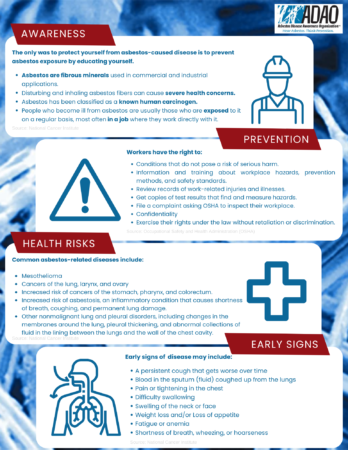Posted on August 30, 2022
ADAO has long believed that awareness and education leads to prevention; it was an honor to work with Earl Dotter last week in New Orleans and Baton Rouge, where we hosted an in-person educational community meeting in New Orleans, Louisiana for workers and their families who have been employed by chemical plants using asbestos diaphragms. 
Occidental Chemical, Olin, and Westlake Chemical Corporations are the only three remaining companies that still use asbestos in their production. Together, with award-winning Occupational and Environmental Health photojournalist Earl Dotter, I presented these communities with valuable government resources to advance prevention, expand knowledge about workers safety from the Occupational Safety and Health Administration (OSHA), and shared the early warning symptoms and treatment information from the National Cancer Institute.
Below are the four chlor-alkali plants in Louisiana that import and use raw chrysotile asbestos in their production of industrial chlorine and caustic soda.
- Occidental Chemical Corporation – Covent, LA
- Occidental Chemical Corporation – Taft, LA
- Olin Corporation – Plaquemine, LA
- Westlake Chemical Corporation – Plaquemine, LA
Chlor-alkali industry is the primary importer and user of raw chrysotile asbestos during the manufacturing process of industrial chlorine and caustic soda. From 1991 to 2019, Louisiana saw 22,953 asbestos-related deaths. According to the Institute for Health Metrics and Evaluation, these deaths were occupational, caused by diseases including asbestosis, larynx cancer, tracheal bronchus, lung cancer, ovarian cancer, and mesothelioma. People of all ages lost their lives to these illnesses.
This trip was planned after comparing our data, maps, and industry propaganda. After creating a route, we drove over 300 miles as we visited the four plants and held an educational community meeting.
 “Storytelling is the best way to help others understand the pain and suffering caused by asbestos exposure and asbestos-caused diseases,” said Earl Dotter. “It was an honor to photograph this area and help raise awareness about the dangers of asbestos exposure. Those living and working near chlor-alkali plants that import and use asbestos are at a higher risk of exposure and developing an asbestos-caused disease than other communities and I appreciated the opportunity to help ADAO share the necessary educational resources and pathways for treatment to all those who are at risk and those who have been affected.”
“Storytelling is the best way to help others understand the pain and suffering caused by asbestos exposure and asbestos-caused diseases,” said Earl Dotter. “It was an honor to photograph this area and help raise awareness about the dangers of asbestos exposure. Those living and working near chlor-alkali plants that import and use asbestos are at a higher risk of exposure and developing an asbestos-caused disease than other communities and I appreciated the opportunity to help ADAO share the necessary educational resources and pathways for treatment to all those who are at risk and those who have been affected.”
Since the Frank R. Lautenberg Chemical Safety for the 21st Century Act was signed into law in 2016, the industry has imported over 2,500 metric tons of asbestos. In 2022, the EPA released a proposed rule to ban chrysotile asbestos in just six conditions of use. Although a landmark step forward, all asbestos fibers are carcinogenic, and there are at least six pathways to exposure. We need to fully ban asbestos in order to protect all Americans.
For the past seven years, Earl Dotter has created an ever-evolving photo exhibit, “BADGES: A Memorial Tribute to Asbestos Workers,” memorializing the asbestos workers of the 20th century and honoring the legacy of famed asbestos treatment pioneer, Dr. Irving J. Selikoff. Earl’s traveling exhibit presents the photo ID badges worn by the countless workers who were exposed to asbestos in mining, manufacturing and product use.
Together we are making change possible.
Linda Reinstein
